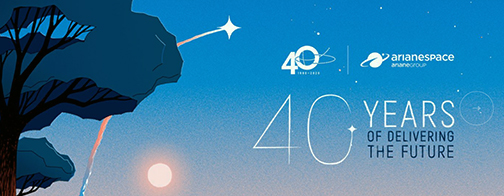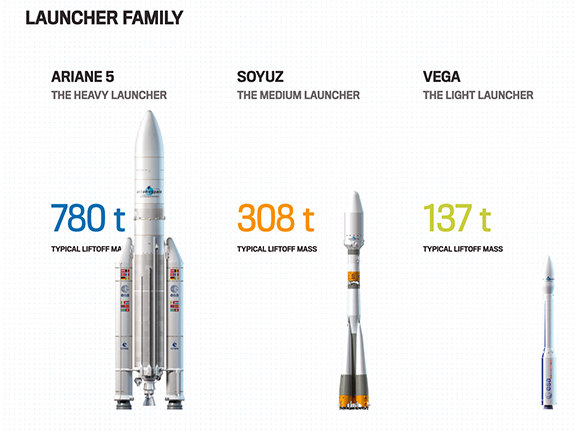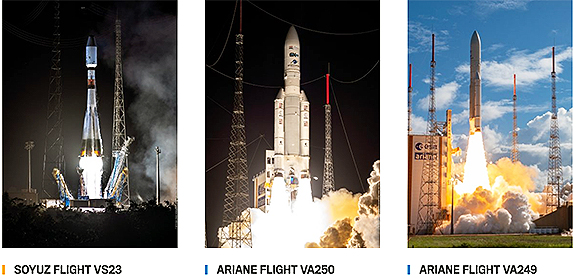
Arianespace recorded a solid operational and business performance in 2019 by orbiting 24 satellites with nine launches, while signing 14 launch services contracts during the year for a total of 44 satellites ranging in mass from six kilograms to nearly six metric tons, marking the flexibility of the company’s commercial offerings.

Arianespace lofted eight GEO satellites last year, versus the six orbited by competitors. Arianespace welcomed the mobilization of the European Space Agency (ESA) Member States at the Space19+ ministerial-level conference in Seville, Spain, and also announced the launch contract for the Euclid scientific mission, the 14th signed in 2019, which may be launched by Ariane 6.
With the flexibility of its product range, Arianespace is targeting new records in 2020 for the number of launches to be performed and the satellites to be orbited, as well as the inaugural missions with Vega C and Ariane 6.
Arianespace has now announced their results for 2019 and their goals for 2020.
2019: Solid operational and commercial indicators
- The launch services company closed out 2019 with solid operational and commercial indicators, signing 14 contracts with 12 customers to launch 44 satellites; while orbiting 24 satellites during the year with nine launches: two for European institutions and seven for commercial customers. Arianespace’s order backlog now stands at nearly €4 billion for 54 launches.
- The company confirmed its leadership in the still-cautious geostationary communications satellite market, having launched a total of eight spacecraft into geostationary transfer orbit, which was more than its competition.
- In 2019, Arianespace also clearly demonstrated the flexibility and complementary of its launcher family – Ariane, Soyuz and Vega – by launching a full range of their payload weight capabilities to all orbits (geostationary with Ariane, intermediate circular and low-Earth orbits with Soyuz, Sun-synchronous with Vega), while also confirming the operational capacity of its teams – including the placement of 13 satellites into orbit during the first quarter of 2019, and the launch of seven satellites with the year’s final two missions.
ESA Member States are mobilized for Europe’s new launchers
- During the year, Arianespace also consolidated the foundation on which the future success of European launchers will be ensured. The mobilization of ESA Member States between the agency’s council meeting in April and the Space19+ ministerial-level conference in November resulted in an order placed with ArianeGroup for the first 14 Ariane 6 launchers, while also finalizing the roadmap for the transition between the current generation of launchers and the upcoming Ariane 6 and Vega C. In addition, Arianespace was named the sole operator of Ariane 6 and Vega C, according to two specific agreements, with the company assuming this responsibility following these launch vehicles’ maiden flights (which are planned for 2020).
- The Ariane 6 backlog continues to grow with today’s announcement of the contract for the Euclid scientific mission, designed by ESA to improve the understanding of black matter in the Universe. Euclid will be compatible with both Ariane 6 and Soyuz – as is the case with the JUICE mission to explore Jupiter’s moons, being compatible with Ariane 6 and Ariane 5. The first two Ariane 6 missions, using the Ariane 62 and Ariane 64 versions, are scheduled for the OneWeb and Viasat operators, confirming that the new European launcher perfectly addresses changing requirements in the commercial launch market.
2020: New Records in View
- Arianespace is heading into 2020 fully prepared to capitalize on the latest commercial opportunities for Ariane 5 and to succeed with Vega’s return-to-flight, planned for March. Arianespace also is aiming to set three new records:
- For the number of launches during the year, with up to 12 opportunities identified from the Guiana Space Center in French Guiana, along with the first flights of Vega C and Ariane 6; and eight more from the cosmodromes at Baikonur and Vostochny. (from this two cosmodromes, this launch cadence could be augmented based on satellite availability),
- For the number of satellites placed into orbit – more than 300 – taking into account the continued deployment of OneWeb satellites and the SSMS rideshare mission with Vega
- For the number of launch pads at its service: four at the Guiana Space Center (for Ariane 5, Ariane 6, Soyuz and Vega/Vega C), along with one each at the Baikonur and Vostochny cosmodromes for Soyuz.

Arianespace's latest, completed missions.
Image is courtesy of the company.
Since 1980, Arianespace has launched a total of 616 satellites for more than 100 commercial and institutional customers from around the world, making a major contribution to humankind’s knowledge of space, the protection of Earth, and improving life on the planet.
Arianespace offers launches into geostationary transfer orbit — the company's legacy core business; as well as new solutions, such as launch services for constellations and for small satellites into LEO as well as rideshare-type launches into geostationary and lunar orbits.
Key Figures for 2019
Nine launches, 24 satellites orbited, 15 customers (13 commercial/export operators), 47 metric tons of payload (including 38 metric tons into geostationary orbit).
Nine launches for 15 customers:
- Four by Ariane 5, dual launches towards geostationary orbit for:
- Arabsat / KACST
- ISRO, the Indian space agency
- AT&T (Direct TV)
- Eutelsat
- Airbus Defence and Space/Avanti, for the EDRS program supported by ESA
- Intelsat
- Airbus Defence and Space/Thales Alenia Space for Egypt
- Inmarsat
- Three by Soyuz for:
- OneWeb
- SES
- Italian Ministry of Defense, ASI, ESA, CNES and space startups HEMERIA and Tyvak
- Two by Vega for:
- OHB Italy on behalf of ASI
- Airbus Defence and Space on behalf of the United Arab Emirates armed forces
24 satellites orbited:
- Eight GEO, four MEO, 12 LEO/SSO
- 18 commercial and six institutional satellites
- 19 communications satellites, two Earth Observation, two scientific, one technology demonstrator
…in multiple configurations:
- Dedicated launch (Vega): PRISMA, an institutional satellite
- Dual launch (Ariane 5): four for commercial GEO customers, and one public-private partnership (EDRS)
- Multiple launch (Soyuz): OneWeb, O3b, Cosmo SkyMed, CHEOPS, OPS-Sat, EyeSat, ANGELS
14 launch contracts signed in 2019:
- Four contracts for Ariane 5 and Ariane 62/64:
- First flight of Ariane 62 for OneWeb (30 satellites)
- JUICE for Ariane 64 or Ariane 5
- MEASAT-3d pour Measat
- Ovzon-3 for Ovzon
(To which is added the transfer of Viasat 3 from Ariane 5 to the first Ariane 64)
- One Ariane 62/Soyuz:
- Euclid for ESA
- Euclid for ESA
- Three contracts for Soyuz:
- EarthCARE for ESA
- 12U deployer for Open Cosmos
- OPS-SAT for Tyvak on behalf of ESA
- Six contracts for Vega/Vega C:
- SEOSat/Ingenio and Biomass for ESA
- StriX-α for Synspective
- ESAIL for exactEarth
- Two 6U deployers for Tyvak
- One satellite for an unnamed customer
54 launches in the backlog:
- 19 by Ariane (10 Ariane 5, five Ariane 62 and four Ariane 64)
- 25 by Soyuz
- 10 by Vega/Vega C
…for 35 customers from around the world, as follows (by number of launches):
- 67% commercial, 33% institutional
- 22% for geostationary missions (GEO), 78% for non-GEO missions
- 57% for telecommunications, 33% for Earth observation, 4% for navigation, 4% for science and 2% for technology demonstrations
2020: in addition to the inaugural flights of Vega C and Ariane 6, up to 20 launches could be carried out to deploy more than 300 satellites.
> As many as 12 launches by Ariane 5, Soyuz and Vega from the Guiana Space Center:
- Five Ariane 5 missions to geostationary transfer orbit, all for commercial/export operators:
- Eutelsat
- ISRO
- SKY Perfect JSAT
- KARI
- B-SAT
- ntelsat and NGIS
- Embratel Star One
- Four by Soyuz:
- The United Arab Emirates’ second FalconEye 2 satellite, on the initial Soyuz launch in 2020
- CSO-2 for French CNES space agency, on behalf of the French Ministry of the Armed Forces
- As many as two missions for the OneWeb constellation
- Three by Vega:
- Flight VV16/SSMS, the first “rideshare” launch, carrying approximately 40 smallsats (as early as March)
- The Spanish governmental Earth observation satellite, SEOSat (Satélite Español de Observación de la Tierra), for CDTI (Centro para el Desarrollo Technologico Industria; the center for the development of industrial technologies)
- The first Pleiades Neo constellation mission for Airbus Defence and Space
- he deployment start-up with the Pléiades Neo constellation for Airbus
> Eight launches from the Baikonur and Vostochny cosmodromes for the OneWeb constellation’s deployment, and potentially more depending on satellite availability.
> Initial launches of Vega C and Ariane 6, under the responsibility of ESA.

